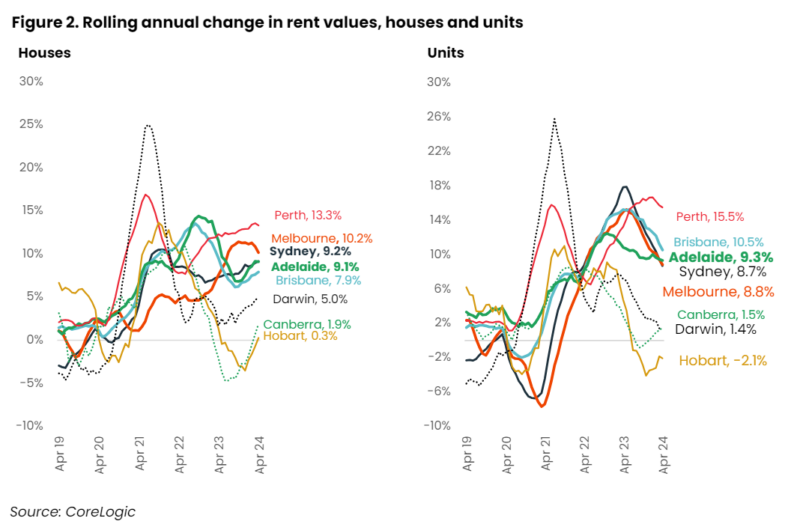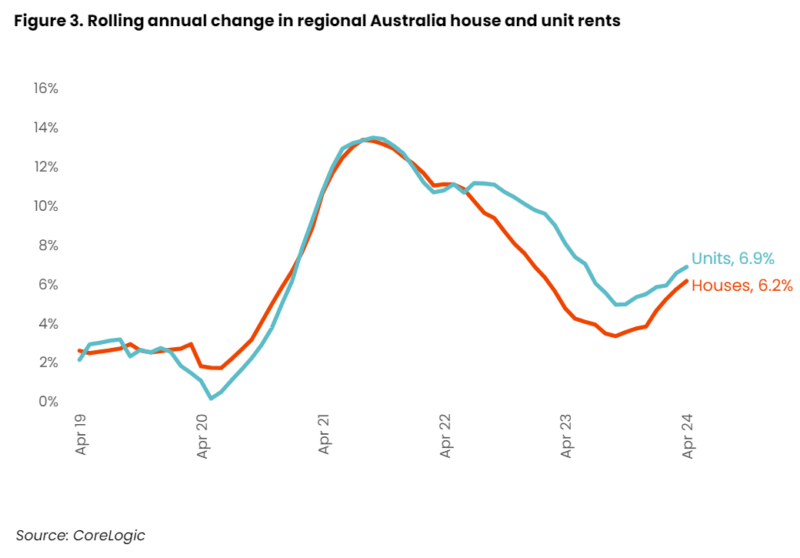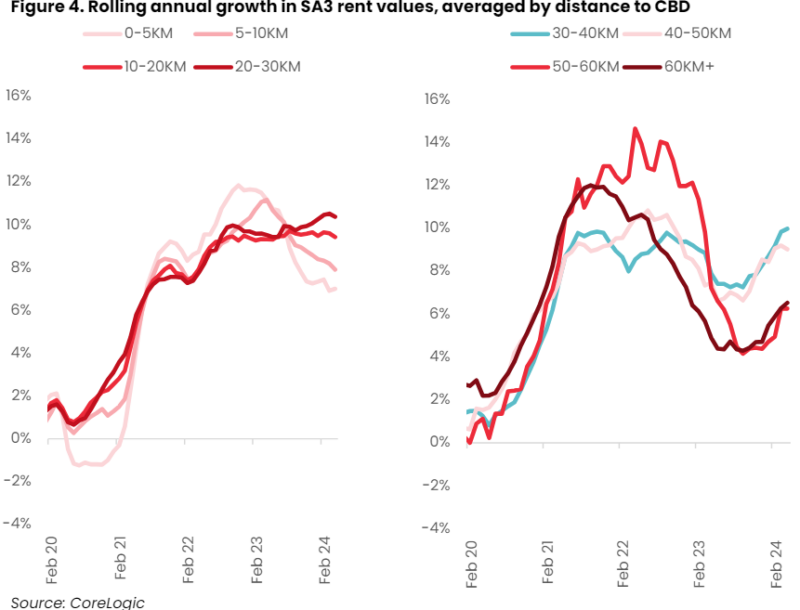[ad_1]

Key takeaways
After a 0.8% rise in April, Australian’s median rent hit a new record high of $627 per week.
Annual rent growth has re-accelerated through 2024, up from a recent low of 8.1% growth in the year to October 2023, to 8.5% in the year to April.
NEW analysis of rents by distance to CBDs shows markets within 30-40km of city centres saw the strongest reacceleration in rent growth.
In Brisbane, Jimboomba’s annual rent growth went from 3.8% to 6.4%, while Casey – North in Melbourne saw annual rent growth from 11.7% to 13.1%.
One fifth (21.3%) of SA3 markets analysed have rents below their peak:
Around 9% of SA3 rent markets were down from peaks in February or March this year, suggesting they were slipping from recent highs.
Other rent markets with more sustained declines from their peak were mostly remote, regional areas, however some pockets of the Sydney rent market were also below peaks from 2023, such as Canterbury, Pennant Hills – Epping and Parramatta.
The median weekly rent value across all Australian dwellings has hit a fresh record high of $627 per week, and rental costs range from $770 per week in Sydney, to $547 in Hobart .
Summary of median weekly rent and value change – data as of April 2024
| Region | Median weekly rent | Monthly change in rents | Quarterly change in rents | Annual change inrents |
| Sydney | $770 | 1.0% | 3.0% | 9.0% |
| Melbourne | $589 | 0.8% | 2.8% | 9.6% |
| Brisbane | $649 | 0.8% | 2.1% | 8.5% |
| Adelaide | $589 | 0.6% | 2.4% | 9.1% |
| Perth | $669 | 1.2% | 3.9% | 13.6% |
| Hobart | $547 | 0.2% | 2.5% | -0.2% |
| Darwin | $617 | -0.3% | -0.1% | 3.5% |
| Canberra | $674 | 0.6% | 1.9% | 1.8% |
| Combined
capitals |
$659 | 0.9% | 2.9% | 9.4% |
| Combined
regionals |
$540 | 0.7% | 2.5% | 6.4% |
| National | $627 | 0.8% | 2.8% | 8.5% |
Source: CoreLogic
Rather than rent increases being limited by affordability constraints, annual rent growth has once again started gathering pace at the start of 2024.
Nationally, annual rent growth went from a recent low of 8.1% in October 2023, to 8.5% in April.
Even markets where rents had been falling are now showing values start to steady or increase again
Figure 2 shows rolling annual growth in house and unit rents by greater capital city area.

Canberra house rent falls bottomed out at -3.4% in the year to September, though rents have been rising over the past seven months, taking the market back into a year-on-year increase of 1.8%.
In Hobart, house rents are back in positive growth territory, and unit rents seem close to flattening out.
Figure 3 shows regional rent growth is also back on the rise.

Annual growth in regional unit rents bottomed out at 5.0% in the year to September and climbed back up to 6.9% in the 12 months to April.
Regional house rents have seen an even more dramatic reacceleration, where annual growth in rents has gone from 3.4% in September to 6.2% in April this year.
The pick up in regional rent growth was most pronounced in regional QLD and Tasmania houses (each saw a pick up in annual growth of 350 basis points between September 2023 and April this year).
Part of the reason for the re-acceleration in rents nationally could be due to renters being forced into more affordable, peripheral housing markets as they become priced out of more desirable and central metropolitan locations.
Areas where rents are slightly lower may offer more space for group households or have slightly less competitive rental conditions which are potentially being more targeted by prospective tenants.
This is reflected in Figure 4, which shows the average annual rent growth across SA3 regions by the average dwelling distance to the nearest CBD.

Between October last year and April this year, growth re-accelerated most strongly in greater capital city areas within 30-40km of city centres.
In Sydney, this included Campbelltown, where annual growth went from 9.1% in October to 13.4% in the year to April.
In Brisbane, this included Jimboomba, where annual rent growth went from 3.8% to 6.4% in the same period.
Casey – North in Melbourne is also within this distance, where annual house rent growth went from 11.7% to 13.1% in the same period.
While these outer-suburban markets are seeing the most rapid re-acceleration in rents, the pickup in rent growth has been fairly broad-based, with only rent markets within 10 km from city centres showing a consistent easing in average annual growth.
Many of these markets are only seeing rent growth ease from a very recent high.
Supply and demand pressures remain high across Australia’s rental market
Outside of these regional variations, supply and demand pressures remain high across Australia’s rental market more broadly.
On the demand side, experimental estimates from the ABS suggest average household size only continued to decline to 2.50 people in June 2023.
This comes despite a material uplift in group households, which was far outpaced by a rise in lone and two-person households.
Net overseas migration in the year to September was just under 550,000, with temporary visa holders accounting for over 90% of this figure.
This means overseas arrivals were particularly likely to skew to rental accommodation through the period.
Considering an average household size of 2.5 people, net overseas migration levels implied new household formation of over 200,000 in the year to September.
At a time when supply constraints persist in the residential construction industry, only 173,000 new dwellings were completed in the same period.
Outlook
Given there is little that can be done on the supply side for renters in the short term, a reprieve in the rental market is most likely to come from a moderation in net overseas migration, as some temporary migrants start to depart, and arrival numbers normalise post-COVID.
Centre for Population forecasts indicate this could occur from the next financial year.
Until then, renters may be seeking more shared accommodation, or exploring cheaper rental markets across the outer metro fringes or regional Australia.
[ad_2]
Source link


